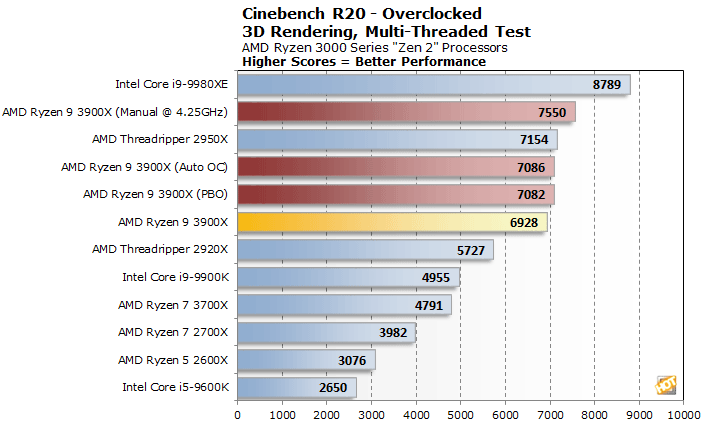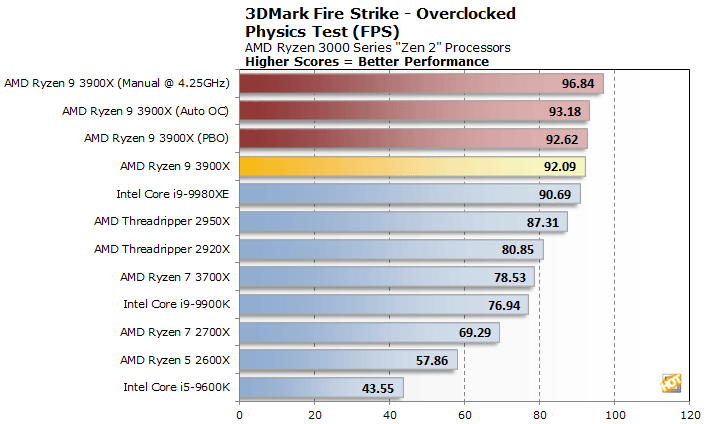AMD Ryzen 9 3900X And Ryzen 7 3700X Review: Zen 2 Impresses
We also spent some time overclocking the AMD Ryzen 9 3900X, to see if we could wring any additional performance from the processor. AMD offers an array of tools for overclocking 3rd Generation Ryzen 3000 series processors, including simple methods like Precision Boost Overdrive and Auto-Overclocking via Ryzen Master, or manual overclocking via the BIOS.
|
Overclocking a 3nd Generation Ryzen processor is very similar to second-gen parts. Because the processors are unlocked, overclocking it is simply a matter of altering a few multipliers, tweaking voltages, and dealing with the additional heat and power requirements. These processors can also be overclocked by adjusting base clock frequencies though, so it's possible to really fine tune the end result.
We took a somewhat conservative approach to overclocking the Ryzen 9 3900X to give you all an approximate “worst case scenario”. Our results should be repeatable, assuming you’ve got similar hardware and everything is working properly. You shouldn’t need exotic cooling to pull off what we did here -- we used the included Wraith Prism cooler with the motherboard and processor installed in a mainstream NZXT mid-tower. Of course, more exotic cooling will result in higher overclocks, but its not a necessity to achieve some significant performance gains. Keep in mind though, that overclocking will void the warranty -- even if using something as simple as PBO.
To see what our chip could do, we manually cranked the core voltage up to 1.44v and shot for a modest 4.2GHz (42x100MHz) all-core overclock, which worked without incident. We then moved up to 4.3GHz, but had some instability under load, so we backed things down a bit and settled at 4.25GHz across all cores. At this speed, the chip was quickly saturating the Wraith Prism Cooler and operated in the mid 90-degree range when under sustained load, which flirted with the 95°C limit presented by Ryzen Master. Idle temperatures were relatively cool and stayed in the mid 30's, however. To gather some additional data, we also tried to Auto-Overclock feature and enabled PBO to see how they affected performance with our setup.


While we had the chip overclocked, we re-ran a couple of benchmarks and saw some nice performance improvements. Obviously the more aggressive manual overclock resulted in the biggest performance gains, and allowed the Ryzen 9 3900X to overtake the 16-core Threadripper 2950X in the Cinebench R20 benchmark. PBO and Auto-Overclocking via Ryzen Master showed smaller gains, that we in-line with one another.
|
Throughout all of our benchmarking and testing, we also monitored how much power our test system were consuming with a power meter. Our goal was to give you an idea as to how much power each configuration used while idling at the Windows desktop and while under a heavy CPU workloads. Keep in mind, this is total system power consumption being measured at the outlet and not the the individual power of the CPUs alone.

Idle power with the Ryzen 3000 series is somewhat higher than expected. We've sent a query to AMD for feedback on our results, but haven't gotten a response just yet. We've heard from some colleagues, however, that they've seen higher-then-expected idle power as well, so we believe these numbers are representative of what consumers will see in the wild. We suspect having a separate IO die, in addition to the motherboard chipset (which is essentially the same chip) is the reason, but don't have a solid answer just yet. Load power looks significantly better though, and shows the Ryzen 7 3700X actually using less power than the 2600X when all cores are being taxed. But when a single core is being whacked, the 3rd Gen Ryzen's more aggressive frequency curve results in higher power consumption. The 12-core Ryzen 9 3900X does use more power then the 8-core Ryzen 7 2700X, but comes in well below the Core i9-9900K.

We also monitored power while overclocked and saw an 85 watt increase under-load, due to the higher clocks and voltages used to hit 4.25GHz. The jump in power while overclocking with PBO or the Auto-Overclock feature is smaller, though still significant. The chips may run relatively cool and quite in their stock configurations, but overclocking can change the equation quite a bit, so a quality cooler is a must-have.








